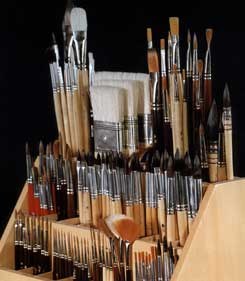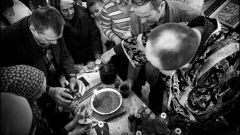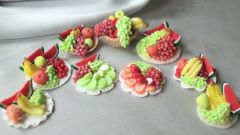Domestic and foreign manufacturers delight us with such a wide range of hands that someone who decided to do what any hobby can be very difficult to choose the right tool. Brush only take sometimes entire departments in stores for artists. How to choose and not to spend a lot?
Let's start with the classification of brushes according to shape. The simplest division is a flat and round brush.
In painting I use a flat brush when working with oil paints, tempera, acrylic, gouache. Round brushes are usually used in watercolor painting, and also the above techniques to render small elements.
How to determine the size. Very often, aspiring artist receives a list from the teacher with the number of brushes required for employment. In the classical numbering, the number of the brush is its size in millimeters. For example, a round brush No. 3 will have a diameter of 3mm. For the flat number is the width, flat brushes are usually numbered in even numbers only. But... there are exceptions to the rule. First, each manufacturer there are many series of brushes that are slightly different from each other, for example, the length of the handle or the length of the exhibition (this is actually what we draw). In each series the numbering can be arbitrary, so the two similar brushes from different series with number 6 and 12 can have almost the same size. Most often recommending the brush number, the teacher has in mind is its size in millimeters. For this to be considered when buying.
The brush can be made from natural hair bristles, proteins, column, cow ear, sable, raccoon , wolf, etc. are Now widespread brush from synthetic hair. On their some characteristics, they can beat brushes with natural hair, but in any case not replace them.
Thus, the bristles. Used for oil painting, acrylic, tempera. The bristles may be rigid and softer depending on the quality of the hair. When choosing pay attention to the tips of the hairs. They should have a natural thinning on the end, and in no case should not be circumcised. Cropped brush fit only for construction works or glue.
Columns. The king of brushes. The most expensive material, but this is the most durable, and suitable for nearly all techniques from oil to watercolor. Hair column is not rigid, but supple at the same time. Color reddish-brown.
Protein. Used mainly for watercolor. Keeps a big drop. Color black or reddish.
Cow's ear. More coarse hair than the whites, even look like speakers, but is inferior in elasticity. Most often used in children's creativity because of its cheapness.
Sable. Similar to columns among domestic brushes rare.
Raccoon. Also a rare visitor to our websites. Elastic tight hair closest to the bristles. Often found in the composition of teams of brushes for calligraphy.
Wolf. Used in calligraphic brushes.
Goat. White hair, similar in appearance to the bristles, but very soft and quite elastic. Goat hair holds a large drop, so used in the composition of a calligraphic brush. Alone are good for some watercolor techniques and painting on fabrics.
When choosing a brush, look closely as it is collected. All hair needs to be tipped up. The brush should not crumble. Professional store for artists, You will always find a container of water to check how they are going brush. The sleeve should fit snugly on the handle.
How to choose a handle - a matter of taste, but in my experience, optimum raw colour handle beech.



